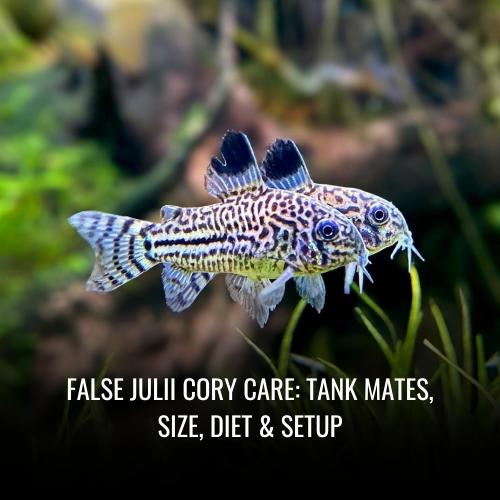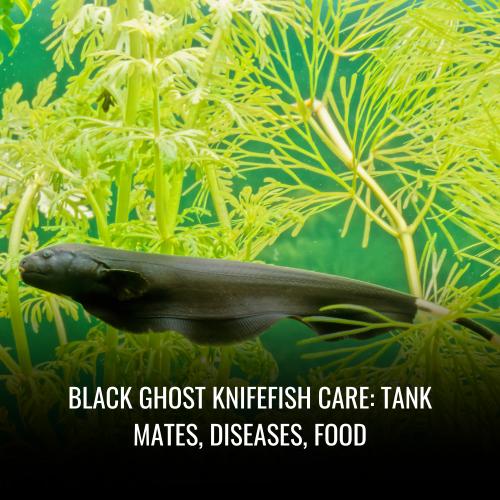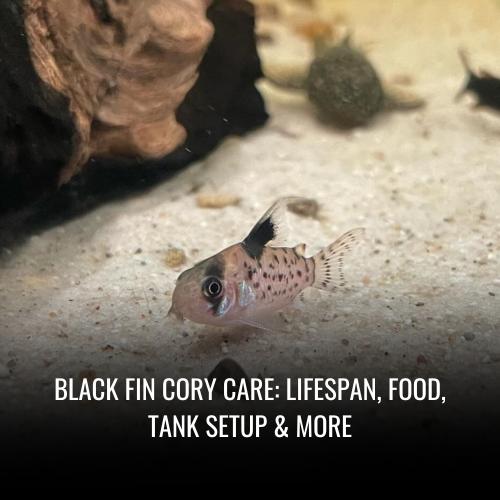As schooling fish, False Bandit Corys flourish in groups and exhibit a peaceful demeanor, making them excellent community aquarium fish. They prefer soft substrate like sand or smooth gravel to protect their barbels while rummaging for food. While they’re not picky eaters, their diet should include high-quality flake food, plant matter, and occasional treats of frozen food to maintain optimal health.
It’s important to note their remarkable resilience to water conditions, yet maintaining recommended water hardness and pH levels ensures their well-being. With proper care, expect these fascinating fish to mature and become a long-lasting addition to your tank. Plus, if you’re interested in breeding, keep an eye on the subtle sexual dimorphism exhibited during maturity.
Below, find a concise table that encapsulates the essential care requirements for the False Bandit Cory:
| Characteristic | Detail |
|---|---|
| Scientific Name | Corydoras melini |
| Common Name | False Bandit Cory |
| Family | Callichthyidae |
| Usual Size in Fish Tanks | 1.5-2 inches (3.8-5 cm) |
| Recommended pH Range | 6.0 – 7.0 |
| Recommended Water Hardness (dGH) | 2-12°N |
| Recommended Temperature | 72-79°F (22-26°C) |
| Reproduction | Egg-layer |
| Origin | Upper Negro and Meta River basins |
| Temperament to Own Species | Peaceful |
| Temperament Toward Other Fish Species | Peaceful |
| Usual Place in the Tank | Bottom |
| Lifespan | 5 years+ |
| Tank Size Requirement | 20 gallons+ |
| Filtration System | Gentle, to mimic their natural slow-flowing waters |
| Sexual Dimorphism | Yes, females are rounder and larger |
| Substrate Cleaning | Necessary as they are benthic scavengers |
This table provides a practical reference for maintaining the health and happiness of the False Bandit Cory in your aquarium. Remember, with a little care and attention, these delicate fish make excellent additions to a well-balanced tank, creating an underwater landscape teeming with activity and color.
Scientific Name
The False Bandit Cory, scientifically recognized as Corydoras melini, is a cherished addition to the family Callichthyidae. This lovely species is a South American native, hailing from its pristine and diverse aquatic systems. Aquarists value the False Bandit Cory not only for its striking appearance but also for the ease of meeting its habitat requirements in domestic aquariums.
Here are some quick key facts about the False Bandit Cory:
| Characteristic | Detail |
|---|---|
| Scientific Name | Corydoras melini |
| Family | Callichthyidae |
| Origin | South America |
| Recommended pH Range | 6.5 – 7.5 |
| Usual Size in Fish Tanks | 5 – 6 cm (1.97 – 2.36 inch) |
Keeping short, informative paragraphs helps to digest this information efficiently, ensuring enthusiasts of all levels can confidently care for their False Bandit Corys.
Average Size
The False Bandit Cory presents an elegant form among freshwater tank inhabitants with their adult sizes ranging comfortably between 1.6 to 2 inches (4 to 5 centimeters). Upon introduction to an aquarium, they are generally smaller, averaging around 1 inch (2.5 cm). This compact size makes them convenient for a range of aquarium setups, as long as the tank meets their space requirements for optimal health.
It is essential for aquarists to provide an environment that allows these catfish to thrive. Here’s a quick guide to their average size:
| Life Stage | Average Size |
|---|---|
| Purchase Size | 1 inch (2.5 cm) |
| Adult Size | 1.6 – 2 inches (4 – 5 cm) |
With their stunning pale, silvery coloration juxtaposed with a vivid black stripe, the appearance of the False Bandit Cory is as striking as it is unique. Despite their armored body, entirely covered in bony plates, they are peaceful creatures. Ideal for group living, keeping them in schools of six or more will cater to their social nature. Enthusiasts should consider a minimum tank size of 15 gallons to provide ample swimming space and maintain the welfare of these captivating freshwater fish.
Lifespan
Corydoras melini, commonly known as the False Bandit Cory, boasts a life expectancy ranging from 3 to 5 years when provided with the right living conditions. Achieving such a lifespan is contingent upon maintaining a clean tank environment and offering high-quality food, which is crucial to their health and longevity.
This species is recognized for its long-standing presence in the river ecosystems, presumably one of the inaugural Corydoras species to venture into these waters. It is suggested that the False Bandit Cory is an ancestral form, paving the way for a multitude of Corydoras species via natural hybridization in their wild habitats.
The reproductive behavior of Corydoras melini is particularly intriguing, with females typically laying only 2 to 4 eggs at one time. This egg-laying process is repeated until the female has deposited about 100 eggs. Here’s an overview of their reproductive stats:
| Reproduction Fact | Detail |
|---|---|
| Eggs Produced Per Batch | 2-4 eggs |
| Total Eggs Laid per Breeding | Up to approximately 100 |
| Frequency of Egg Laying | Repeated Until Completion |
By adhering to their specific care requirements, aquarists can help ensure that these captivating creatures enjoy a full and healthy life within the tropical climate of a well-kept aquarium.
Natural Habitat
Corydoras melini, affectionately known as the False Bandit Cory, is indigenous to the lush aquatic landscapes of the upper Rio Negro and Meta River Basins, as well as the meandering Orinoco River, traversing the regions of northwestern Brazil and east-central Colombia. These captivating freshwater fish find sanctuary in the uniquely stained waters of flooded forest areas, where organic compounds steep like tea, infusing the water with a rich, dark hue.
The pristine blackwater rivers and creeks of their habitat manifest an ideal haven for these Corydoras, where the water is characteristically soft, slightly acidic, and remarkably low in conductivity—mirroring the conditions needed for their prosperity in captivity. The table below encapsulates the quintessential environmental conditions of the False Bandit Cory’s natural habitat:
| Characteristic | Details of Natural Habitat |
|---|---|
| Water Color | Tea-like due to organic chemicals |
| Acidity | Slightly acidic |
| Hardness | Very little, soft water |
| Conductivity | Low |
| Climate | Tropical, with seasonal water temperature and chemistry variations |
Admired for their ability to adapt and thrive, these fascinating fish have developed special adaptations to survive the tropical climate’s seasonal shifts, which mark their native aquatic environments. Maintaining these conditions is vital for their well-being in home aquariums, where these tiny, delicate fish can be wonderful additions to a tranquil underwater community.
Appearance
The False Bandit Cory, also known by its scientific name Corydoras melini, boasts a distinctive appearance characterized by a horizontal black stripe running along its body. This stripe is a key feature distinguishing it from its relative, the true bandit Corydoras known as Corydoras metae.
Astonishingly, their appearance can alter post-shipping due to stress—initially presenting a faded facade that gradually regains vibrancy as they acclimate. Coloration in these fish is also influenced by factors including mood, age, gender, and social hierarchy.
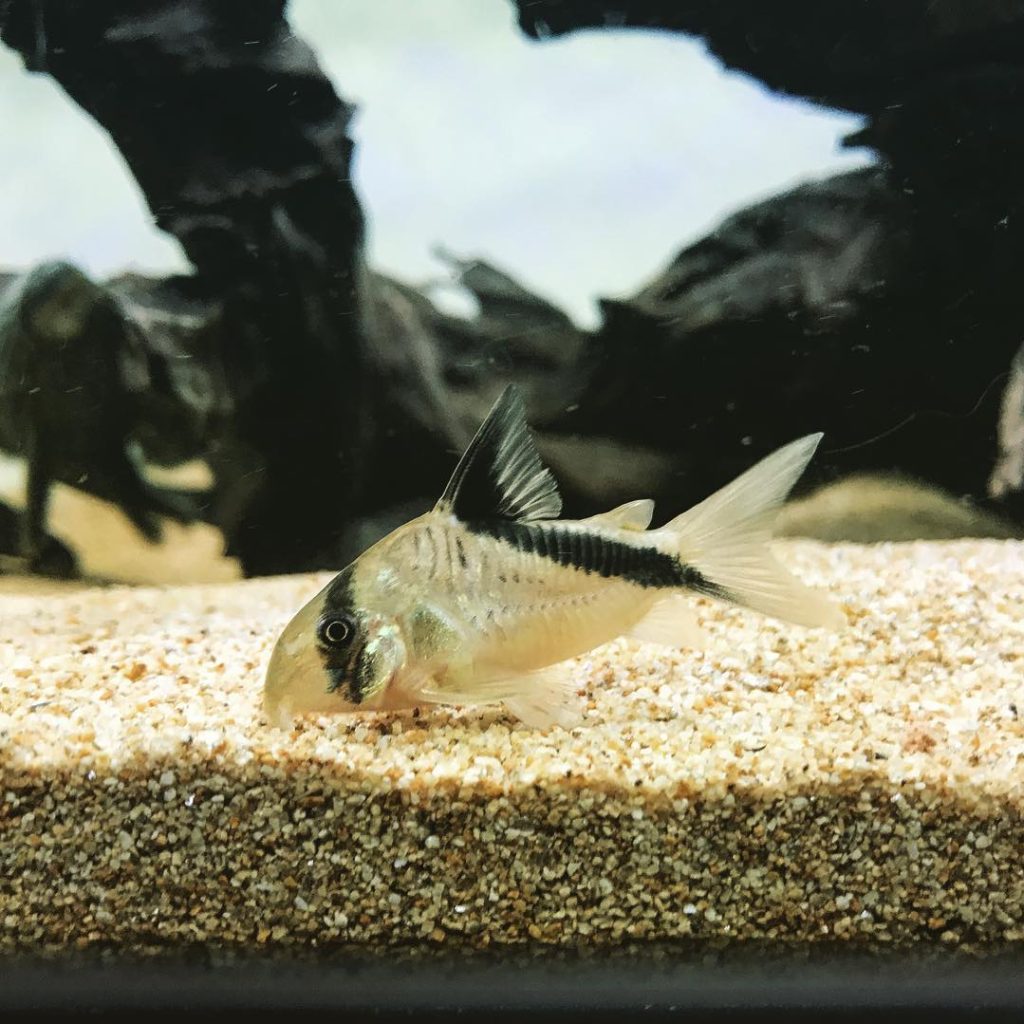
Sexual dimorphism is pronounced within this species. Females typically exhibit a plumper and more rounded body shape, clearly observable from an aerial perspective, making them discernibly larger than their male counterparts. Male False Bandit Corydoras are sleeker with a more streamlined silhouette. Furthermore, a comparison of dorsal fins can aid in gender identification; males may flaunt a longer and sharper dorsal fin.
Here’s a concise comparison of the male and female characteristics:
| Sex | Body Shape | Dorsal Fin |
|---|---|---|
| Male | Streamlined | Extended & Pointed |
| Female | Broader & Larger | Standard |
Through observation, aquarists can enjoy the subtle complexities and variations present in these dynamic and enchanting fish.
Behavior & Temperament
False Bandit Corydoras, scientifically known as Corydoras melini, are a captivating species known for their tranquil nature and sociable behavior. As bottom-dwellers, they sift through the substrate with their sensitive barbels, scouring for food particles without exhibiting any form of aggressive tendencies.
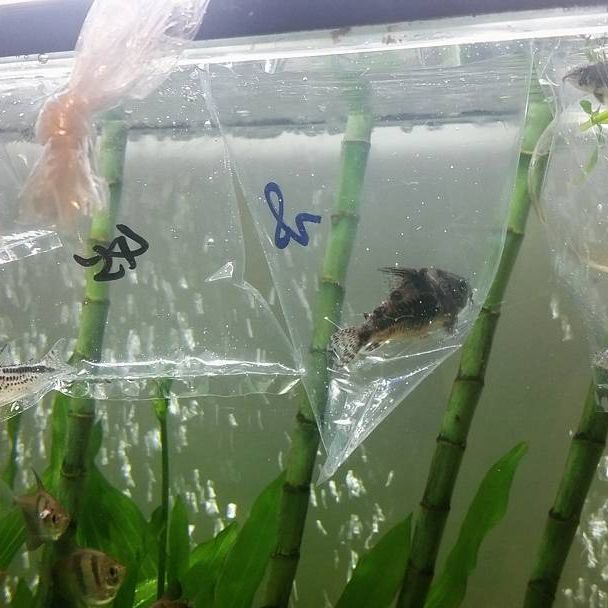
Are False Bandit Cory Fin Nippers?
These peaceful freshwater fish do not engage in fin-nipping. Their well-developed pectoral and pelvic fins, while impressive, are not utilized for aggressive behaviors. This makes them ideal residents in an aquarium aiming for a peaceful cohabitation among various species.
Are False Bandit Cory Aggressive To Each Other & Other Fish?
Within the aquarium, False Bandit Corydoras maintain a benign presence, refraining from aggressive interactions with their counterparts or other fish. They naturally seek companionship from their own species, preferring a pacific social environment. This characteristic allows them to effortlessly blend into community tanks that house other non-aggressive fish.
Are False Bandit Cory Friendly To Each Other & Other Fish?
Indeed, False Bandit Corys are friendly toward each other and thrive in a community setting. They often socialize near the aquarium’s floor in a congenial and playful manner. Their peaceful demeanor extends to their tank mates, making them excellent community aquarium fish, especially when sharing space with other placid species such as Pencilfish, Tetras, and Rasboras.
Are False Bandit Cory Schooling Fish?
False Bandit Corydoras are quintessential schooling fish. They naturally gravitate towards forming groups, exhibiting the calm and synchronized swimming patterns that are typical of Corydoras species. Keeping these fish in a group not only supports their wellbeing but also encourages natural behaviors such as foraging and interactive play.
Can You Have Just One False Bandit Cory In The Tank?
It is not recommended to keep a solitary False Bandit Cory, as they could experience stress or loneliness without their school. These social creatures depend on group dynamics for their emotional and physical health. A lone Corydoras melini is likely to become withdrawn and less active, missing out on the benefits of communal living.
Do False Bandit Corydoras Need To Be In Groups?
Given their shoaling nature, the species’ welfare must maintain them in groups of five or more. This not only ensures that False Bandit Corydoras display their natural behaviors but also contributes to a more lively and dynamic aquarium display. Hence, grouping these gregarious fish is essential to mirror their endemic social structure and provide a thriving environment.
To summarize their community dynamic, here’s a quick reference chart:
| Behavior | False Bandit Corydoras Reaction |
|---|---|
| Fin Nipping | Do not engage in fin-nipping |
| Aggression Toward Others | Non-aggressive |
| Social Interaction | Highly social and friendly |
| Schooling Requirement | Yes, best in groups of 5+ |
| Suitability for Solo Life | Not suitable, require groups |
Enthusiasts interested in these serene and benthic crustaceans will find that providing a suitable habitat with soft gravel substrate, tropical climate settings, and proper water hardness will enrich the exhibition of their unique behaviors and sociable nature.
Food & Diet
Although False Bandit Corydoras (Corydoras melini) might occasionally nibble on algae, it is not a substantial part of their diet. These specialized bottom feeders focus on eating food items that sink to the aquarium floor. Their primary diet should consist of high-quality sinking flake food and pellets or tablets tailored for bottom dwellers. To maintain their optimal health and well-being, it’s preferable to provide a variety of food sources that mimic their natural dietary intake rather than relying on algae.
Supplementing their diet with nutritious options like brine shrimp, daphnia, and bloodworms ensures they get a mix of the protein-rich diet they need, instead of depending on algae as their main nutritional source.

Do False Bandit Cory Eat Shrimp?
False Bandit Corydoras are peaceful omnivores and have a diet that can include small crustaceans, such as shrimp. Nevertheless, they are not aggressive hunters; rather, they are scavengers that consume what they find on the substrate. In a community tank, these corys will coexist harmoniously with dwarf shrimp and other invertebrates without showing aggression towards them. A well-rounded diet for the False Bandit Cory should consist of a mix of sinking pellets, algae wafers, and occasional treats like bloodworms to satisfy their carnivorous side, with small shrimp being a part of this diverse menu.
Do False Bandit Cory Eat Bloodworms?
Bloodworms are a welcome supplement to the diet of the False Bandit Corydoras. These fish appreciate a mixed diet, and adding live or freeze-dried bloodworms provides them with the necessary animal protein that is crucial for their growth and vitality. While their diet should be based around high-quality flake food and sinking pellets or tablets, including bloodworms as an occasional treat can help ensure these captivating freshwater fish receive all the necessary nutrients they need to thrive in an aquarium setting.
Do False Bandit Cory Eat Mosquito Larvae?
False Bandit Corydoras will eat mosquito larvae, and they are indeed part of their natural diet in the wild. Incorporating live or frozen mosquito larvae into their feeding regimen can provide an additional source of nutrition and introduce variety. Such dietary enrichment is beneficial for their overall health and can enhance their foraging behavior, which is a natural instinct for these intriguing fish. Offering mosquito larvae can also serve as an enticing live food that stimulates active feeding and allows aquarists to observe some of the most authentic behaviors of these bottom-dwelling species.
Do False Bandit Cory Eat Planaria?
While False Bandit Corydoras do not specifically seek out planaria to consume, they may incidentally ingest small planarians that they come across while foraging for food on the substrate of their tank. Planaria, being soft-bodied invertebrates, could be part of the incidental intake during their routine scavenging activities. However, planaria are not necessary for a balanced diet and are not typically considered a valuable dietary component for these fish.
Do False Bandit Cory Eat Plants?
False Bandit Corydoras are not herbivores and typically do not eat plants as a significant part of their diet. While they may occasionally graze on plant matter, their feeding habits largely revolve around protein-rich foods such as sinking carnivore pellets, flakes, and freeze-dried or live foods. It is essential for aquarists to understand that plants in a tank with False Bandit Corydoras serve more as shelter and environmental enrichment rathe than a food source. An adequate diet for these interesting fish species should prioritize appropriate protein sources to fulfill their nutritional requirements.
To aid aquarists in providing the best care for their False Bandit Corydoras, here is a simple reference table summarizing their dietary preferences:
| Food Type | Do False Bandit Corydoras Eat It? | Notes |
|---|---|---|
| Algae | Rarely | Supplement with protein-rich foods instead. |
| Shrimp | Occasionally | As part of a mixed diet; not aggressive towards shrimp. |
| Bloodworms | Yes | Good as an occasional treat for protein variety. |
| Mosquito Larvae | Yes | Can mimic natural diet; good for nutritional variety. |
| Planaria | Incidentally | Not a necessary part of their diet. |
| Plants | Rarely | Do not primarily eat plants; plants provide tank enrichment. |
By following this dietary guide, aquarists can ensure their False Bandit Corydoras receive a well-rounded and nutritionally adequate diet, contributing to the overall health of these unique and captivating freshwater fish.
Sexing: Male vs Female
Sexing False Bandit Corydoras, or Corydoras melini, can be subtle but noticeable with careful observation. Male False Bandits are distinctively smaller and more streamlined than females. Their sleek bodies and pointed ventral fins align with their active role during spawning. Females, on the other hand, display a rounder and plumper profile, especially when gravid with eggs, and exhibit rounded ventral fins.
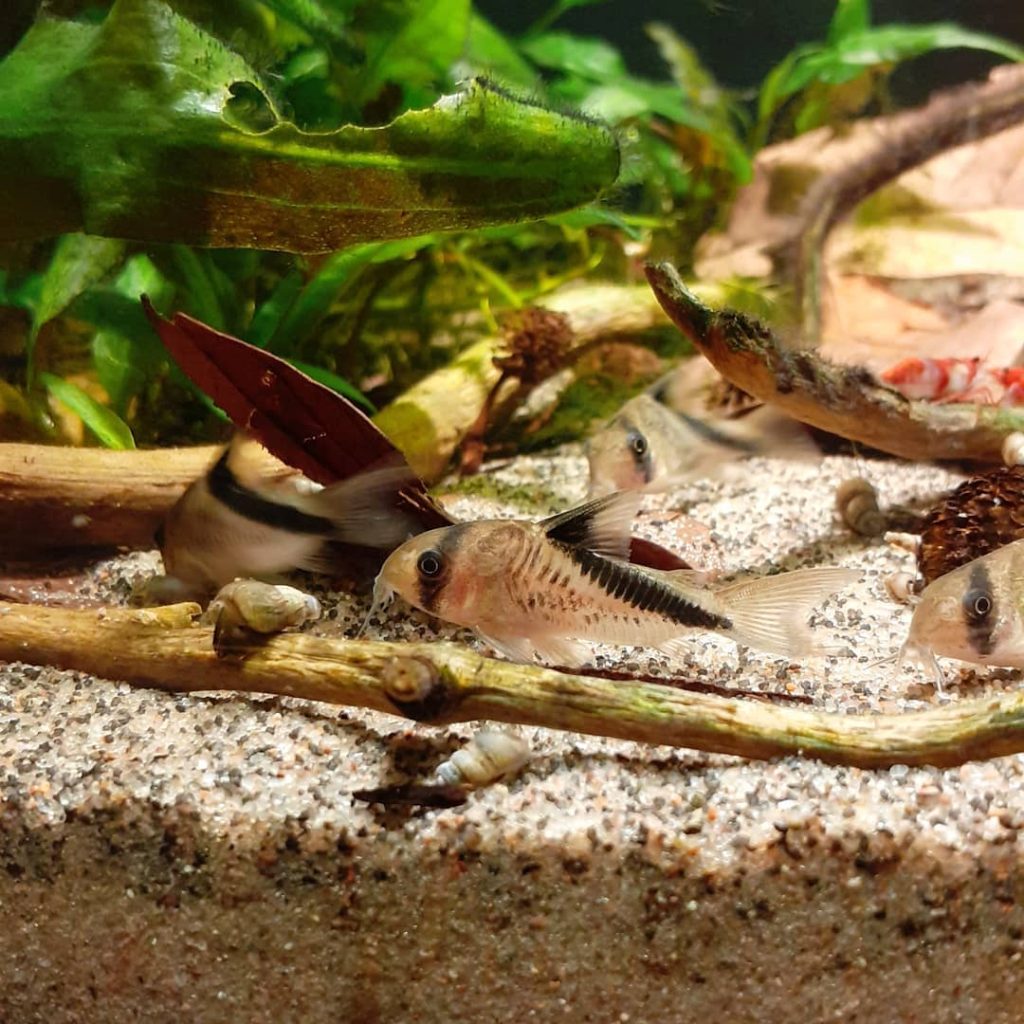
The demarcation of sexual dimorphism in Corydoras melini is less striking compared to other Corydoras species. This can indeed make sex determination a bit of a challenge. However, when these fish are well-conditioned, the differences become more discernible. A top-view is particularly telling, with females having a noticeably broader underbelly.
Here’s a simple table to aid in distinguishing between the two sexes:
| Sex | Body Shape | Size | Ventral Fins | Profile View |
|---|---|---|---|---|
| Male | Slender | Smaller | Pointed | Streamlined, more elongated |
| Female | Rounder | Larger, Plump | Rounded | Wider, especially when viewed from above |
Males of Corydoras melini also tend to be less girthy compared to their female counterparts, further aiding identification when considering their overall size and length.
False bandit cory Tank Mates
Corydoras melini, commonly known as False Bandit Cory, makes an excellent community aquarium fish due to its peaceful disposition. These captivating freshwater fish prefer being in groups of at least five, creating an engaging display of social interaction at the bottom of the tank. For a harmonious aquatic environment, it’s ideal to pair them with other tranquil species that occupy different water layers.
With their serene nature, False Bandit Corys are compatible with small, peaceful midwater swimmers such as Pencilfish, Tetras, and Rasboras. These tankmates serve as dither fish, encouraging the False Bandits to exhibit their natural bottom-dwelling behaviors more confidently. Such tank composition ensures a dynamic and balanced ecosystem.

Having compatible species that dwell in upper layers of the tank invites the False Bandit Corys to forage with their barbels, sifting through the substrate in search of food. This activity is both fascinating to watch and essential for maintaining a healthy and active tank environment.
Here’s a quick list of suitable tankmates for False Bandit Corydoras:
- Pencilfish
- Tetras
- Rasboras
Pairing them appropriately furnishes your aquarium with lively interaction and a thriving community across all aquatic strata.
Aquarium Setup
Creating the perfect home for the False Bandit Cory (Corydoras melini) is crucial for their health and happiness. These small and peaceful fish thrive in well-filtered, established aquaria that mimic their native blackwater habitats in the Upper Negro and Meta River basins. A minimum tank size of 30 gallons is recommended as it provides ample space for them to swim and forage.
The environment can be enhanced with a soft, sandy substrate, alongside thoughtful aquascaping that includes live plants, smooth-edged rocks, and driftwood. By setting up an adequate and biotope-inspired aquarium, you can ensure your False Bandit Corys will live a contented and natural lifestyle.
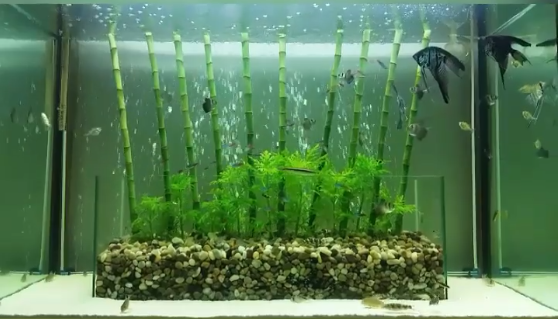
Ideal Tank Size
For the False Bandit Cory, ample space is paramount. Despite some resources suggesting smaller tank sizes, starting with a 30-gallon tank is preferred. This volume offers sufficient room for a small group of these fish to demonstrate their intriguing behaviors and interact comfortably with their tank mates.
Ideal Water Parameters
False Bandit Corys prosper in water that closely resembles their natural habitat. The ideal pH range is between 6.0 and 7.5, with water hardness sitting at 0-14°N (0-250ppm). Temperature wise, they are best suited to conditions ranging from 78-82°F. To safeguard their health, ammonia and nitrite levels should be kept at 0ppm, while nitrates are best kept under 30ppm. Regular water changes are essential to maintain these parameters, thus promoting a thriving ecosystem for your False Bandit Corys.
Filtration
Adequate filtration is indispensable in creating an optimal living environment for the False Bandit Cory. Since they hail from slow-moving, pristine waters, the filtration system should provide clean, well-oxygenated water without creating strong currents that can stress them out. Good filtration helps manage ammonia, nitrite, and nitrate levels, contributing to overall tank health. A filter rated for the tank size with adjustable flow settings can cater to the needs of these sensitive, bottom-dwelling fish.
Lighting
False Bandit Corys do not have strict lighting requirements, but they do best with subdued lighting that simulates the dim conditions of their natural habitat. Using LED aquarium lights with adjustable intensity or placing floating plants can help diffuse light and create shaded areas, offering your False Bandit Corys a comfortable and stress-free environment where they can thrive. It is essential to provide a consistent light cycle to maintain the rhythm of life for all the inhabitants in the aquarium.
Common Possible Diseases & Prevention
Maintaining health for your captivating False Bandit Cory (Corydoras melini) involves several key preventative measures:
- Quality Food: Regularly provide high-quality flake or frozen food enriched with plant matter to ensure balanced nutrition.
- Tank Maintenance: Perform consistent water changes and clean substrates to prevent disease-inducing pollutants.
When Introducing New Fish:
- Observation: It’s typical for new pond or aquarium fish to hide initially. Watch for this behavior over 2-3 days to differentiate between stress acclimation and potential illnesses.
Nutrition for Varied Species:
- Varied Diet for Goldfish: While Sera goldy flakes are recommended, it’s crucial to include a diverse diet for optimal goldfish health.
Unique Species Requirements:
- Mudskipper Survival: Certain unique fish, like Atlantic mudskippers, can thrive both in and out of water environments.
Plant Maintenance:
- Regular Pruning: Control growth of plants in the aquarium. Overgrown vegetation can negatively impact water quality and fish health.
Regular tank care and keen observation are essential in preventing diseases and ensuring your False Bandit Cory remains a delightful inhabitant in your excellent community aquarium.
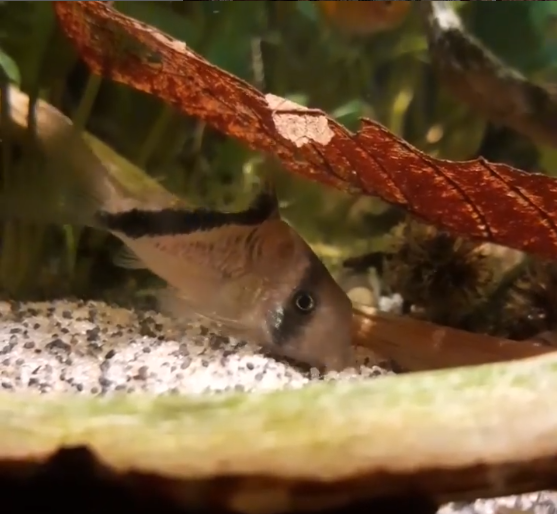
Breeding False bandit cory In Aquarium
Breeding the False Bandit Cory (Corydoras melini) is a rewarding challenge for dedicated aquarists. These captivating freshwater fish, known for their dashing black stripe, exhibit a natural inclination to shoal. Creating a shoal of five or more can significantly enhance breeding success in the aquarium environment.
Due to their rarity as tank-bred specimens, breeding False Bandit Corys becomes an even more fascinating endeavor. For an optimal breeding setup, a minimum tank size of 76 liters (20 US gallons) is required, with water temperatures carefully maintained between 22.2-26.1°C (72-79°F).
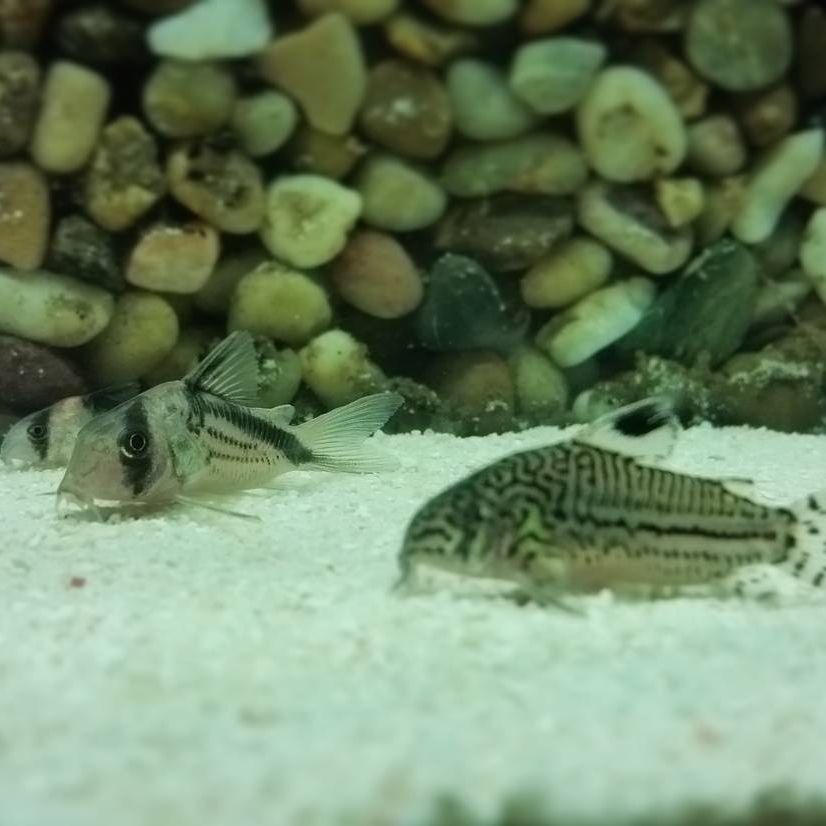
A peaceful, well-maintained habitat is crucial for encouraging breeding. Suitable tankmates include small Pencilfish, Tetras, and Rasboras, all of which contribute to a tranquil climate in the water, reducing stress for the False Bandit Corys.
Breeding these fish involves providing breeding caves and ensuring balanced nutrition through a diet of high-quality flakes and frozen food. By maintaining appropriate water hardness and a gravel substrate within the tank, and providing benthic crustaceans for added dietary variety, aquarists are likely to witness the delightful experience of a successful breeding cycle.
Breeding Setup & Parameters:
| Tank Size | Temperature | Tankmates |
|---|---|---|
| ≥76 L (20 gal) | 22.2-26.1°C | Pencilfish, Tetras, Rasboras |
To conclude, breeding False Bandit Corydoras requires attention to their social nature, proper tank conditions, and a stress-free environment with compatible fish species. With these factors in place, these exquisite fish can successfully reproduce, adding a touch of intrigue to any excellent community aquarium.

